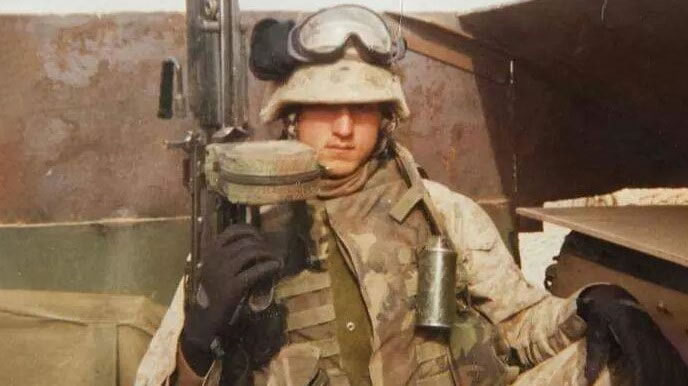
The Baltimore Museum of Art is committed to presenting exhibitions and programs that demonstrate art’s relevance in contemporary culture. While Monsters & Myths: Surrealism and War in the 1930s and 1940s explores art from the previous century, the BMA’s special tours with U.S. Marine Corps veteran Hans Palmer provide a first-person perspective on a more recent experience of war that makes the surreal real.

Monsters & Myths shows how artists responded to the monstrosities around them during the Spanish Civil War and World War II through 90 paintings, sculptures, artist’s books, and films. During the introduction to Hans’ tour, BMA Manager of Tour Experiences Suzy Wolffe explained that Pablo Picasso, Salvador Dalí, Joan Miró, André Masson, and many other artists channeled their experiences of war, violence, and exile into their art, creating some of the most compelling works of the Surrealist movement. Like most people, I enjoyed seeing the hyperrealism in Dalí’s monstrous dreamscapes, the Minotaur symbolism in Picasso’s prints, and the gory details in Masson’s paintings, but seeing some of these artworks through the eyes of someone who has lived through war was a completely different experience.
Hans served two tours in Iraq and he candidly shared his experiences during the 45-minute tour. He had selected five of the 90 objects in the exhibition that were created by artists who either served during World War I and/or were affected by World War II. Hans spoke to how he related to the works with unvarnished commentary on the realities of being in the military while Suzy offered insights on the artists.

The first object Hans selected was Erwin Blumenfeld’s The Dictator (c. 1937). For him, this shadowy photograph of a dead cow’s head with a cape epitomized the long and twisted arm of authority. His disillusionment came as a result of his second tour in Iraq when he was confronted with the unfathomable orders given to the troops and the eventual devastation that came as a result of our government’s foreign policies. Blumenfeld’s image exudes both the authority and indifference of a despotic leader and is a far cry from the glamorous fashion photography that Suzy told us the artist would become known for later in his career.
André Masson’s The Metaphysical Wall (1940) represented the anguish Hans felt over the futility of the military’s actions. After an ambush, Hans believed that he was going to die and dedicated his efforts to saving his friends. The adrenaline rush from the experience led him to feel he as though he had transcended his body and was filled with greater strength and purpose. The encapsulated figures at the bottom of the painting reminded him of the friends and pieces of himself left behind. Suzy told us that Masson had fought and was severely wounded in WWI and suffered from “shell shock,” now known as PTSD.

One of Masson’s other works, In the Tower of Sleep (1938), led to a thoughtful discussion about trench warfare, the artist’s experience of lying in a trench overnight after being shot in the lung, and his long and painful recovery. While looking at the gutted body in the image, Hans shared details about battlefield medical practices for lung wounds during the 1930s as well as their treatment today. Our group contemplated the sad parallels between the rise of morphine addiction after WWI and the current opioid epidemic. Suzy told us that the word grenade is used in French for both the weapon and the pomegranate fruit, which helped explain the gaping head with juicy red seeds spilling out of it. She also explained that after the war Masson developed an extreme aversion to the color red, which is used abundantly to nightmarish effect in this painting.
The tour concluded with Max Ernst’s Europe After the Rain II (1940–42). Ernst fought in WWI for the Germans, but changed his allegiance during Hitler’s rise to power. The crumbling structures on the right side of Ernst’s painting reminded Hans of Ramadi, the town he returned to during his second tour of duty in Iraq. Every building was either littered with bullet holes or demolished by air strikes. This was particularly ironic since Hans was not allowed to call for air or artillery support when he was on the ground during his first tour. Suzy mentioned that the red rocks on the left side of the painting are reminiscent of Sedona, Arizona, where Ernst visited and later lived during his exile in the U.S.
This intense tour gave me deeper insights into the artworks—including Joan Miró’s Portrait No. 1 (1938)—and provided me with a more visceral understanding of the challenges artists faced while working during times of life and death.
Hans and Suzy will lead a tour of Monsters & Myths on Saturday, May 18, at 5 p.m. Tickets are available at artbma.org.
This exhibition and related programs have been made possible in part by a major grant from the National Endowment for the Humanities and by generous funding from Transamerica,
The Alvin and Fanny B. Thalheimer Exhibition Endowment Fund, and The Gladys Krieble Delmas Foundation.




